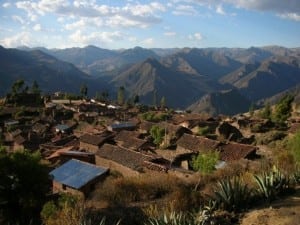Does air travel negate the “sustainable” part of “sustainable engineering for global development?” Solely in terms of greenhouse gas emissions, the answer may be yes, but only if the stay abroad is short.
“Short trips (i.e. less than a month), particularly to far-flung destinations, are almost certainly futile from an environmental sustainability perspective,” Josh Kearns, the science director at the non-profit water, sanitation and hygiene organization Aqueous Solutions, told E4C.
Travelers from affluent regions may be able to offset the damaging emissions from their air travel simply by living a lower impact lifestyle in the developing region where they work. Kearns developed the Break-Even Ecological Footprint (BEEF) calculator, a new online tool to make that calculation. With a few clicks and simple drop-down menus, BEEF determines the minimum amount of time that travelers would have to stay abroad to cancel the damage from their flights out there.
For example, if native New Yorkers fly to Thailand and live like a lifestyle similar to that of a Thai farmer, then over time they may cause less harm to the environment than they would have if they had stayed home. The longer these travelers stay abroad, the less environmental damage they cause relative to their former lifestyles in their home countries. Comparing that difference to the damage from flight emissions yields the length of time that they need to stay in Bangkok to cancel the damage from their flights out there.
“In the humanitarian-engineering and sustainable-development sectors there is a proliferation of tools for project monitoring and evaluation. However, no attention seems to be paid to the environmental impact of engineers and development workers themselves at home and abroad. The Break-Even Ecological Footprint is meant to quantitatively address this component of overall project sustainability,” Kearns says.
BEEF under the microscope
Kearns’s calculator relies on three important numerical estimates and some assumptions that should feed some interesting discussion. Kearns explains the calculator in-depth in a post at Aqueous Solutions.
Flight emissions and radiative forcing
The most straightforward estimate in BEEF is the carbon dioxide emissions for which each traveler on a flight would be responsible. Those figures come from carbonfund.org, a carbon-offset and climate-change education provider.
CO2 is not the only greenhouse gas that jets emit, however, so BEEF offers a second calculation of flight emissions that takes “radiative forcing” into account. Jet exhaust contains compounds such as nitrous oxides and ozone that, when launched into the atmosphere from machines soaring at 30,000 feet, may contribute to global warming. In general, radiative forcing is simply the amount of sunlight and other energy that enters our atmosphere compared to the amount that leaves it. When those numbers are not equal, we experience global warming (or cooling). MIT’s news explains the general term. http://web.mit.edu/newsoffice/2010/explained-radforce-0309.html
The upshot for air travel is that you can multiply CO2 emissions by a “radiative forcing factor” to account for the altitude at which the CO2 is emitted and also for other potentially harmful compounds in the exhaust. Carbon Independent explains in more detail.
How to calculate the impact of our lifestyles
To quantify the impact that the average person in a given country might have on the envirnoment, Kearns borrows a unit called the “global hectare.” Global hectares
A global hectare represents a symbolic hectare of land that supports our lifestyles, Kearns says. The unit accounts for broad categories of economic activity.
“Categories include farmland, fisheries, timber and forest products, built-up space, energy resources and waste assimilation capacity. The global hectare is meant to be a commensurable unit that combines these diverse land types and ecosystem services using yield factors and equivalence factors,” Kearns says.
BEEF draws on global hectare estimates from the Global Footprint Network, which has calculated the numbe rof global hectares each person would need to live in dozens of cities worldwide. The estimates rely on databases such as the UN Food and Agriculture Organization’s Statistical Database.
The calculator provides a sliding bar on a spectrum of “Living a local lifestyle” to “Living a home-country lifestyle” to estimate the impact of lifestyles abroad.
What about carbon offsets?
BEEF raises some interesting questions. One of those is the issue of buying carbon offsets for flights. Kearns skirts the topic in his explanation of BEEF, but he leaves this link to an argument that offsets are dubious.
He also mentions limitations of his calculator, such as the data from which the ecological footprint is drawn, the difficulty in assessing an “average” lifestyle and where one’s own lifestyle might fit in the spectrum. And Kearns acknowledges that the calculator makes no attempt to quantify the potential environmental benefits of the work that the traveler does abroad.
At its worst, then, BEEF is merely a starting point for discussion. But at its best, it might figure into development engineers’ future travel plans.
Related resources
An ancient filtration material removes pesticides from drinking water
Josh Kearns’ new research shows that biochar produced in a simplified gasifier strips agrochemicals from water.- New forecasting and analytics tools could improve wind-energy generation worldwide
IBM’s new technology could boost wind and solar projects in developing countries and the rest of the world. - Improving the improved cookstoves: Standards, test centers and tips
Dynamic new standards could improve cookstove quality.

